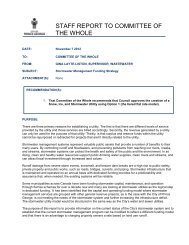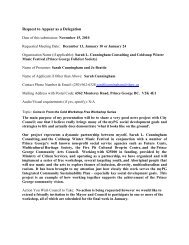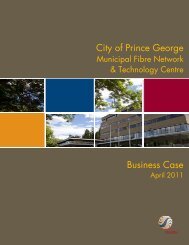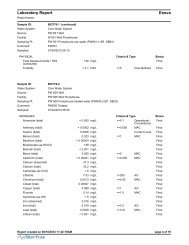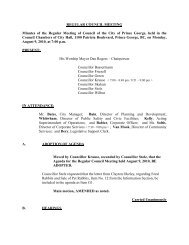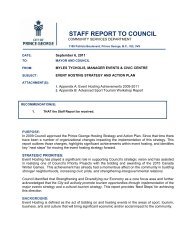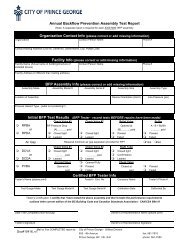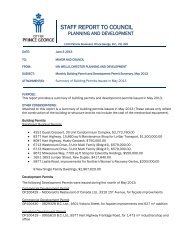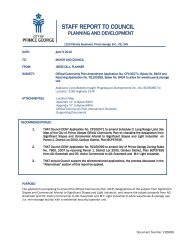Blackburn Wastewater Treatment Plant Upgrade Study
Blackburn Wastewater Treatment Plant Upgrade Study
Blackburn Wastewater Treatment Plant Upgrade Study
Create successful ePaper yourself
Turn your PDF publications into a flip-book with our unique Google optimized e-Paper software.
Section 3.0 -Audit of Existing Facilities<br />
secondary digester. Sodium percarbonate is added to the digesters for<br />
hydrogen sulphide and odour control.<br />
The digested sludge is dewatered on belt filter presses manufactured by<br />
Envirex. Each press has a 2 rn wide gravity section, and a 1 m wide pressure<br />
section. The presses are operated for 7 h/4 4 to 5 &week. Percol757 polymer<br />
and a potato starch based product (Raifix) are used as coagulants. The presses<br />
produce a sludge cake with a dry weight solids content of approximately 22<br />
percent.<br />
3.3 Operations Staff<br />
The <strong>Blackburn</strong> and Lansdowne Road WWTPs are operated by a full time sta!T<br />
of eight persons consisting of one Class IV chief operator, a laboratory<br />
technician, 2 Class I1 operators, and 4 Class I operators. The operating staff<br />
are all based at the Lansdowne Road facility, where most of their duties are<br />
carried out. One operator spends 1 hld, 7 dweek to do a daily inspection at the<br />
<strong>Blackburn</strong> WWTP, and 4 hours once monthly to do the effluent composite<br />
sampling and preventive maintenance. Other City tradespeople (millwright,<br />
electrician, instrument technician) are called to the plants on an "as required"<br />
basis.<br />
3.4 Conclusion<br />
The existing Lansdowne Road WWTP was designed for an ADWF of 44.5<br />
Mud and a PWWF of 115 Mud. The plant is currently treating<br />
approximately 30 MU& or 67 percent of its design flow and load, and does not<br />
appear to have any unit processes in either the liquid or sludge treatment<br />
streams that are close to capacity and may serve as a "bottleneck" if flows to<br />
the plant were increased by a modest amount. The current dry weather flows<br />
and loads h m the Blackbum catchment represent less than 2 percent of the<br />
design capacity of the Lansdowne Road WWTP. The current wet weather<br />
flows (i.e. prior to implementation of the VI mitigation measures) represent<br />
less than 5 percent of the hydraulic capacity of the Lansdowne Road WWTP.<br />
Even with the expected increase in flows and loads from Blackbum sewage<br />
collection area as a result of increasing the serviced population to 5,000, these<br />
flows and loads represent less than 4 percent of the design capacity of the<br />
Lansdowne Road WWTP.




